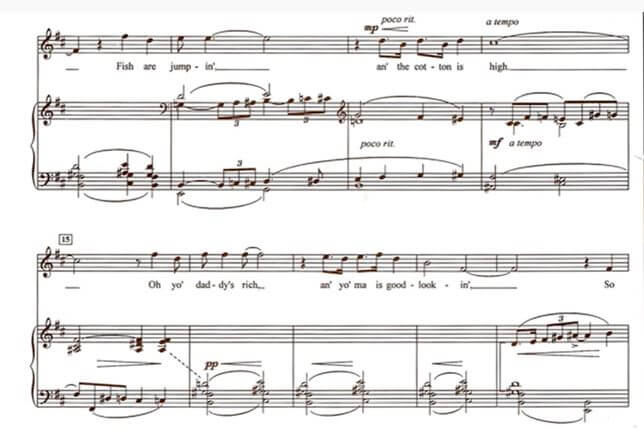SUMMERTIME – an aria from Porgy and Bess
The portrait of George Gershwin’s aria SUMMERTIME
Read Interesting facts and hear great YouTube Videos about the famous Aria “SUMMERTIME“.
If you want to read and hear more about PORGY AND BESS, click on this link to the opera portrait
The aria SUMMERTIME – Synopsis & Background
Synopsis: Charleston in the twenties . Catfish Row was abandoned by the Whites. Now poor black people live in the run-down houses. In one house couples are dancing and Jasbo Brown sits at the piano. Clara, the wife of the fisherman Jake sings a lullaby to her little son.
Summertime is one of the most beautiful songs Gershwin ever composed. It comes from his opera “Porgy and Bess” and he used it in 3 different scenes of this opera. It appears for the first time prominently at the beginning of the opera.
In order to catch the authenticity of the music of “Porgy & Bess”, Gehrshwin spent some time in the south, but composed all the pieces himself. According to his own statements, he did not use any folk songs. Occasionally “Summertime” is associated to a spiritual called “Sometimes I Feel Like a Motherless Child”. The relation between the two remains speculation (see below the playlist with Mahalia Jackson’s interpretation).
Gershwin composed a “classical” lullaby in swaying 2/4 time and tonal basis. Chromatisms, jazz harmonies, an accompanying buzzing choir and a colorful orchestration give the song, besides the beautiful melody, an unmistakable and beautiful character.
The piece does not contain any special difficulties for the singer, it moves in a comfortable tonal range (from f-sharp to f-sharp). Many singers add syncopated notes and decorate the aria (especially at the end) with octave jumps and glissandi, which of course increases the difficulty of the piece.
A short introduction by the strings and the soothing sounds of a clarinet and gentle tones of the chime lead into the gently rocking 2/2 time of a lullaby.
After the opening phrase in B flat minor (I), Gehrshwin composes a classical short cadenza (“Fish are jumping” – IV; “and the cotton is high”-V; “your ma is good looking”-I), during which the orchestra competes this tonal section first with sixth chords (in the bass) which are repeated 3 thimes and sound almost Debussy like, and then with chromatic development, creating a floating feeling.
When the introductory melody reappears, a solo violin and a women’s humming choir appear. The chorus is notated in p (piano) and takes over the harmonies of the orchestra and thus is only faintly audible. The solo violin is even notated in pp (pianissimo) and therefore almost not audible.
The orchestral colours become richer and richer, soon the English horn, oboe and flute stand out from the orchestra.
Gershwin finishes this piece with a beautiful final effect. While the singing voice holds the final B, the buzzing choir goes up in the air. The singing voice often uses this long lasting B with further effects like octave jumps and glissandi.
Vocal fach
The role of Clara is written for a lyrical soprano. The lyrical soprano must have a voice with a warm timbre and must be able to convince with a bell-like sound in the high register. This should be colourful and must not sound forced. The middle register must be rich.
The Aria – the text of SUMMERTIME
The text is by DuBose and Heyward, who were also the authors of the novel.
Summertime, an’ the livin’ is easy
Fish are jumpin’ an’ the cotton is high
Oh, yo’ daddy’s rich and yo’ ma is good-lookin’
So hush, little baby, don’ you cry
One of these mornin’s you goin’ to rise up singin
Then you’ll spread yo’ wings an’ you’ll take the sky
But till that mornin’, there’s a nothin’ can harm you
With Daddy an’ Mammy standin’ by.
Famous interpretations of SUMMERTIME
It is estimated that there are over 25,000 recordings of this piece, most of them by jazz and pop greats. Naturally it is difficult to make a selection.
Leontyne Price is probably the operatic blueprint of the interpretation. She was part of the 1952 world tour cast that produced the opera’s worldwide breakthrough and later one of the greatest soprano of the after war period. The recording is from the 1963 RCA recording.
Summertime – Price
We first hear Ella Fitzgerald in her legendary Berlin concert in 1968. The interpretation is very reserved, almost introverted.
Summertime – Fitzgerald
Ella Fitzgerald recorded the song with various greats of jazz music, as in the following example with Louis Armstrong. We hear the first verse with Armstrong’s trumpet. Then the two sing alternately, Armstrong with his sandpaper voice and Fitzgerald with her clear pure voice – the contrast could not be bigger.
Summertime – Fitzgerald
Janis Joplin’s version became famous not least because of Woodstock. We hear her hippie version with guitar solos and marijuana scent.
Summertime – Joplin
One of the earliest (the earliest?) recordings is by Billie Holiday. It is an arrangement / improvisation in classic New Orleans style, which quickly found its way into the charts. She has worked with many of the greats of jazz music in her early years, yet her biography remains a string of grotesque abuse by others, her mother no exception.
Summertime – Holiday
Mahalia Jackson made a gospel-style medley of Summertime with the related “Motherless Child” a folk spiritual.
Summertime / Motherless Child – Jackson
Peter Lutz, opera-inside, the online opera guide to the song “SUMMERTIME” from the opera “Porgy & Bess” from George Gershwin.








Leave a Reply
Want to join the discussion?Feel free to contribute!